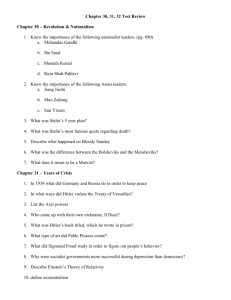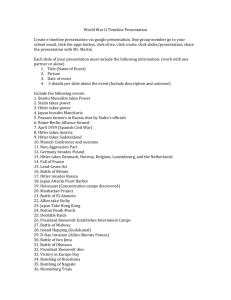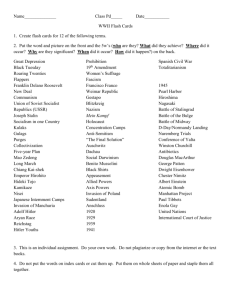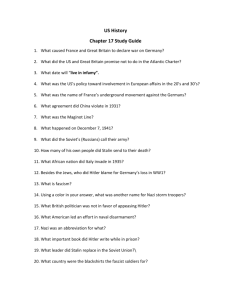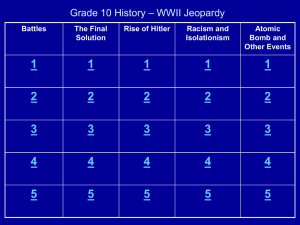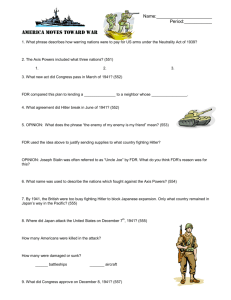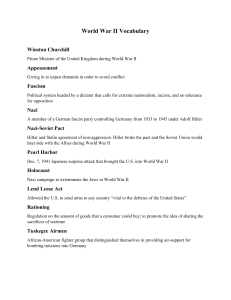Name Date Period______ Chapter 34: Origins of World War II How
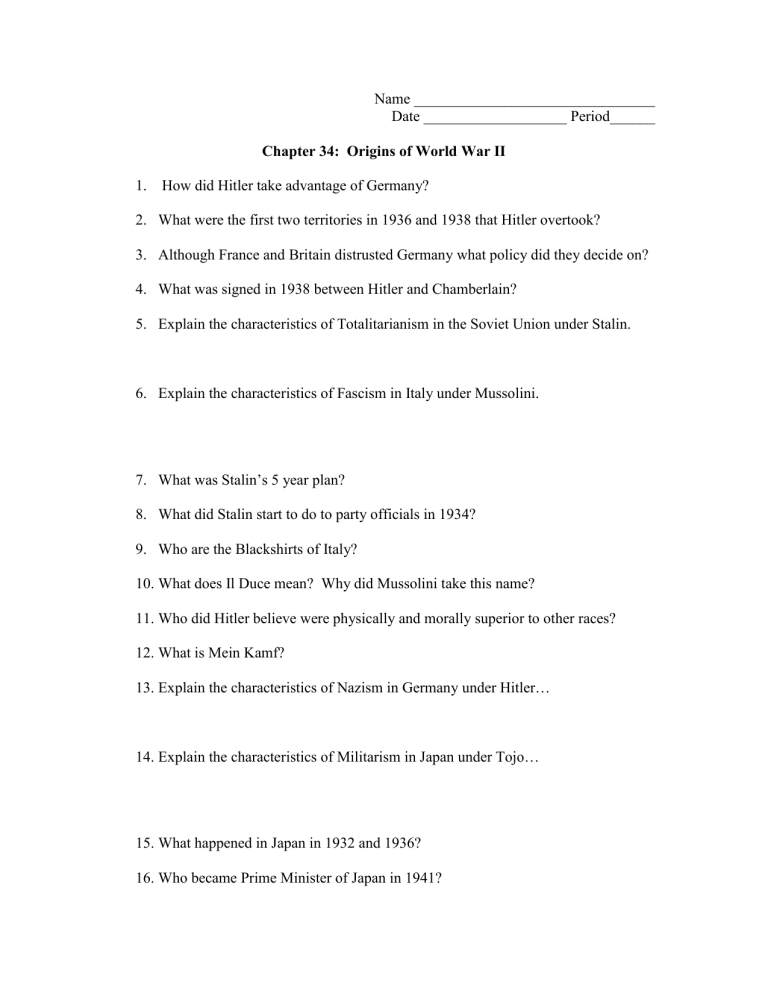
Name ________________________________
Date ___________________ Period______
Chapter 34: Origins of World War II
1.
How did Hitler take advantage of Germany?
2.
What were the first two territories in 1936 and 1938 that Hitler overtook?
3.
Although France and Britain distrusted Germany what policy did they decide on?
4.
What was signed in 1938 between Hitler and Chamberlain?
5.
Explain the characteristics of Totalitarianism in the Soviet Union under Stalin.
6.
Explain the characteristics of Fascism in Italy under Mussolini.
7.
What was Stalin’s 5 year plan?
8.
What did Stalin start to do to party officials in 1934?
9.
Who are the Blackshirts of Italy?
10.
What does Il Duce mean? Why did Mussolini take this name?
11.
Who did Hitler believe were physically and morally superior to other races?
12.
What is Mein Kamf?
13.
Explain the characteristics of Nazism in Germany under Hitler…
14.
Explain the characteristics of Militarism in Japan under Tojo…
15.
What happened in Japan in 1932 and 1936?
16.
Who became Prime Minister of Japan in 1941?
17.
Where was Japan’s sphere of influence in China?
18.
What is the Rape of Nanjing?
19.
What else did Japan add to its empire by 1941?
20.
Where did Italy invade in 1935?
21.
What was occurring in Spain in 1936? Who was leading the Spanish Military?
22.
What is Anschluss and how was this used by Hitler?
23.
What did congress pass in 1936 and 1937 to keep the country out of conflicts?
24.
How did Hitler break the Munich pact in March 1939?
25.
Who was the Nonaggression pact signed between?
26.
Who did Germany attack with a blitzkrieg “lightening war”?
27.
Who did Hitler focus on after their victory over Poland?
28.
What was referred to as the phony war?
29.
Who did Germany surprise attack in April of 1940?
30.
Who became known as the Axis powers?
31.
How did Germany plan to take over Great Britain?
32.
How did the RAF help in the victory of the Battle of Britain?
33.
What is the Tripartite pact?
34.
What was the Cash and Carry provision of the Neutrality Act of 1939?
35.
How did the United States try and undercut Japan’s aggression?
36.
What happened on December 7 th
, 1941?
37.
What did Roosevelt do the next day?
Name ________________________________
Date ___________________ Period______
Chapter 35: The Impact of World War II on Americans
1.
What are some sacrifices everyone made in support of the armed forces?
2.
What was the War Productions Boards’ main task?
3.
What were the increases in GDP, Total Personal Income, and Business income?
4.
What did the Revenue Act of 1942 due?
5.
How did Roosevelt explain Supply and Demand in his fireside chat?
6.
Why did the OPA administer Price controls? What were some of the goods the
OPA rationed?
7.
Why did soldiers get nicknamed GI’s?
8.
At which forts did draftees and recruits get their first taste of military life?
9.
What did the jumping and live-ammunition exercises call for?
10.
Who did FDR declare to be “enemy aliens?” and what did they have to do?
11.
Why did the Japanese face much harsher discrimination?
12.
What was the Supreme Court Case Korematsu V United State’s Verdict?
13.
Describe an internment camp… then list some ways people were allowed to leave the camp.
14.
How did the fictional Rosie the Riveter come to represent women during WWII?
15.
Why did women face the hardship of working a “double shift?”
16.
On the first day of registration, how many women signed up for WAC?
17.
What is the double V campaign?
18.
How did the Tuskegee Airmen gain their reputation?
19.
What happened in 1943 in Detroit Michigan?
20.
The NAACP and National Urban League did not want to undermine the war effort but this group took a tougher stance at confronting discrimination.
21.
Fill in this time line of Jewish Perseuction by the Nazi’s. a.
1933 after Hitler took power ____________________________________ b.
Nov. 9 th
1938 ________________________________________________ c.
1939 the St. Louis ____________________________________________ d.
July 1942 NY City ____________________________________________ e.
1944 FDR’s executive Order ____________________________________
22.
How did Jewish American’s handle becoming GI’s?
23.
What type of Units did a higher percentage of Mexican American’s fight in compared to all other types of groups?
24.
What were the contracts for braceros?
25.
What is a Zoot Suit? Which two groups clashed during the Zoot Suit Riots? Who won?
Name ________________________________Date __________________Period______
Chapter 36: Fighting World War II
1.
What were the groups of German U-boats called?
2.
How did the allies reduce their losses of U-boat attacks?
3.
When and why did Churchill and FDR meet in 1941?
4.
Which country battled Germany in the air?
5.
Which country was successful due to a harsh winter?
6.
Who drove into North Africa and Egypt?
7.
What was the Jewish Question Hitler was trying to solve?
8.
Where did the final solution slaughter start and which countries did it go through?
9.
How were Death camps different than concentration camps?
10.
In addition to Jews, who else did the Nazi’s kill?
11.
What were some options of attack by the allies?
12.
When and where was America’s first series of battles?
13.
Who were the generals of US troops in N. Africa?
14.
When and why did Italy surrender? What did they do the next month?
15.
Why would Stalingrad be considered a turning point in the War in Europe? What was the outcome?
16.
What became the prime target of Allied Strategic bombing? Why?
17.
What type of planes and pilots favored precision bombing? Who favored saturation bombing?
18.
What did Elie Wiesel state about the possible bombing of Auschwitz?
19.
How and where did the invasion of D-Day take place?
20.
Who was liberated in August 1944?
21.
How did the SS try and hide evidence of concentration camps in Poland?
22.
What happened to the many living skeletons after they were liberated?
23.
What percentage of the world’s Jewish population had been killed?
24.
What was Hitler’s last counter offensive called?
25.
On April 30 th
1945, what happened to Hitler?
26.
Which president celebrated VE day? Why?
27.
How did Japan form the Co-Prosperity Sphere?
28.
Which territories had Japan conquered by the end of March 1942?
29.
Explain the Bataan Death March.
30.
Why did the US help China?
31.
Where did Doolittle’s Raid occur and how did they stop the Japanese?
32.
The battle of Coral Sea was the first battle in history where…….
33.
What were some of the options in the Pacific?
34.
Why were the Navajo Indian’s so important???
35.
Why would the Battle of Midway be considered a turning point in the war?
36.
What was the cost of leapfrogging?
37.
Which battle was the bloodiest of the war in the Pacific?
38.
How many American and Japanese soldiers died at the battle of Okinawa?
39.
What is Japan’s new weapon the Kamikaze pilot?
40.
Who informed FDR about the atomic bomb?
41.
What did Oppenheimer witness on July 16 th
in New Mexico?
42.
List positive and negative outcomes to dropping the atomic bomb?
43.
Explain the destruction of Enola Gay on Hiroshima. What was the outcome of
Nagasaki?
44.
Why did Truman have no regrets? When was V-J day celebrated?
Name ________________________________
Date ___________________ Period______
Chapter 37: The Aftermath of WWII
1.
Why did the War’s end bring uncertainty to the US?
2.
What were American concerns about maintaining peace and the League of
Nations?
3.
What is the policy of internationalism?
4.
What is another name for the International Bank for Reconstruction and
Development?
5.
What was the goal of IMF?
6.
What was a goal of GATT?
7.
Which countries gathered to create the United Nations? How many nations signed the charter?
8.
What was the senate’s vote to ratify U.S.’s membership into the UN?
9.
In 1941 Roosevelt and Churchill incorporated the Four Freedoms into this?
10.
Why did the UN adopt the Universal Declaration of Human Rights?
11.
What was the crisis in Palestine?
12.
What were the allied demands after WWII of Germany and Japan?
13.
What are the Nuremberg Trials?
14.
Which countries were represented in the Tribunal?
15.
What happened to the 22 defendants in Germany?
16.
What happened to the 25 defendants in Japan?
17.
What was General MacArthur in charge of in Japan?
18.
What was signed in 1951 in Japan?
19.
Why was unemployment worse after WWII?
20.
What were GI’s able to do because of the GI Bill of Rights?
21.
How did the lives of African Americans improve during the Post war years?
22.
Most women stepped aside to give men jobs and other women transitioned from industry jobs to service sector jobs such as…….
23.
What was the Nuremberg Charter in 1864?
24.
In which country were the Geneva Conventions held?
25.
What did Pol Pot do?
26.
What type of crimes did the ICTY prosecute more than 50 people for?
27.
What happened in Rwanda in 1994?
28.
Why did one U.S. official say that the US might be accused of war crimes for legitimate but controversial uses of force to protect world peace?
Appeasement
Munich Pact
Totalitarianism
Joseph Stalin
Fascism
Benito Mussolini
Nazism
Adolf Hitler
Militarism
Hideki Tojo
Japan’s empire
Spanish Civil War
Francisco Franco
Neutrality Acts
Blitzkrieg
Mobilization
Puppet Government
Lend Lease Act
Pearl Harbor
Name ________________________________
Date ___________________ Period______
Chapter 34: Origins of World War II
Vocabulary
Name ________________________________
Date ___________________ Period______
Chapter 35: The Impact of World War II on Americans
Vocabulary
Rationing
War Productions Board
Gross Domestic Product
National War labor Board
Tax Revenue Act of 1942
Price Controls
GI’s
Executive Order 9066
Kormatsu v United States
Internment Camps
442 nd Regimental Combat Team
Rosie the Riveter
Women’s Army Corps
WAVES
Double V Campaign
Tuskegee Airmen
CORE
Kristalnacht
War Refugee Board
Zoot Suit Riots
U-boats
Axis Powers
Allied Powers
Final Solution
Counter offensives
Battle of Stalingrad
Precision bombing
Saturation bombing
D-Day
Holocaust
Genocide
Leapfrogging
Battle of Midway
Battle of Okinawa
Kamikaze
Manhattan Project
Albert Einstein
Atomic bomb
Robert J Oppenheimer
Hiroshima and Nagasaki
Name ________________________________
Date __________________Period______
Chapter 36: Fighting World War II
Vocabulary
Name ________________________________
Date ___________________ Period______
Chapter 37: The Aftermath of WWII
Vocabulary
World Bank
International Monetary Fund
General Agreement on Tariffs and Trade
United Nations
Four Freedoms
Declaration of Human Rights
Human Rights
War Crimes
Nuremburg War Crimes Trials
General George MacArthur
Sovereignty
GI Bill of Rights
Median Income
Service Sector
Geneva Conventions
International Criminal Court
